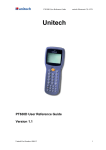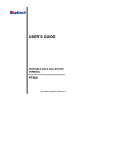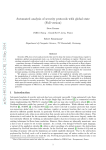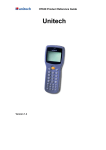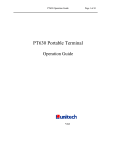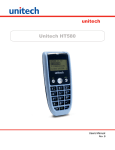Download WDT2200 User Reference Guide
Transcript
. WDT2200 User Reference Guide Version 1.0 © 2003 Wasp Technologies, Inc. -0- . NOTICE This unit is equipped with a Li-ion battery pack. Battery power might be low due to storage. Recharge the battery when required. For procedures on how to charge the battery, please refer to page 5. © 2003 Wasp Technologies, Inc. -1- . Table of Contents WDT2200 User Reference Guide ............................................................................................................................ 0 Version 1.0 ............................................................................................................................................................... 0 NOTICE ................................................................................................................................................................... 1 Table of Content....................................................................................................................................................... 2 Chapter 1: Introduction ............................................................................................................................................ 3 1.1 Overview ............................................................................................................................................ 3 1.2 Support ............................................................................................................................................... 3 1.3 Customized WDT2200..................................................................................................................... 3 1.4 Technical Specifications .................................................................................................................. 4 1.5 Quick Start ......................................................................................................................................... 5 1. 6 Interface Ports .................................................................................................................................. 2 1.7 Using the Keyboard .......................................................................................................................... 2 1.8 Triggering Scanner Module............................................................................................................... 4 1.9 Application Development Environment............................................................................................ 4 Chapter 2 Power System............................................................................................................................................ 5 2.1 Power System ................................................................................................................................... 5 2.2 Power Low Indication ....................................................................................................................... 5 2.3 Battery Replacement ........................................................................................................................ 6 2.4 Recharging the Battery Pack........................................................................................................... 6 2.5 Storage and Safety Precautions ..................................................................................................... 7 Chapter 3 Operation ................................................................................................................................................. 8 3.1 Ready Mode....................................................................................................................................... 8 3.2 User Mode and System Commands .............................................................................................. 8 3.3 Configuring the Terminal via the SET command.......................................................................... 10 3.3.1 DATE & TIME: ................................................................................................................. 10 3.3.2 SCANNER:....................................................................................................................... 10 3.4 Upload/Download by ESC Command............................................................................................ 11 Chapter 4 Built-in Application: FormCaching ......................................................................................................... 12 4.1 Specification of FormCaching ......................................................................................................... 12 4.2 How to Configure FormCaching ..................................................................................................... 13 4.3 How to Run FormCaching ............................................................................................................... 13 4.4 Default Setting of FormCaching...................................................................................................... 13 © 2003 Wasp Technologies, Inc. -2- . Chapter 1: Introduction 1.1 Overview Thank you for choosing this product from Wasp Technologies, Inc. The WDT2200 portable data collection terminal is one of the most versatile handheld computers available. It is DOS compatible, capable of running programs developed with the C language. The WDT2200 has many pre-built in functions and is also userprogrammable. The WDT2200 is light, weights only 230 grams, has a large liquid crystal display (128 pixel X 64 pixel, capable of displaying 16*8 or 8*4 characters,) is rugged and water proof. It also capable of withstanding multiple 1.5 meter drops. Depending on you’re the particular model you had purchased, your terminal is equipped with 2.5MB Laser or CCD Scanner. The WDT2200 also has offers optional RS232 communication/charging cradled. Working with the WDT2200’s unique universal power adaptor, the cradles will satisfy your WDT2200’s charging and communication needs. 1.2 Support Contact Wasp Technologies Technical Support via http://support.waspbarcode.com 1.3 Customized WDT2200 It is highly likely when you receive this terminal; that a system integrator has already program your terminal to meet your specific application. If this is the case, many operating procedures, mentioned in this manual, may not apply. Please consult your system provider for more information regarding such customization. © 2003 Wasp Technologies, Inc. -3- . 1.4 Technical Specifications Physical Physical Characteristics Dimensions: 165mm x 60mm x 35mm Weight: 230g Drop Specification: 1.5M multiple free drop to concrete floor Display: 128 x 64 pixel; 8 x16 characters or 4 x 12 characters. Battery: (include main and backup battery) Environmental Sealing: Operating Temperature: Storage Temperature One 3.7V/880mAH Li-ion battery; One Cr2032 3V/190mAH Lithium backup battery Humidity: 5% to 95% RH, ; not condensed Electrostatic Discharge (ESD) Back-Lit Display: 4 KV for contact discharge 8 KV for air discharge Yes Keypads: 26 alphanumeric keys + one scan trigger IP54 -5C~50 C -20C~70 C Performance Performance Characteristics CPU: NEC V25 (16 bit); 80XX compatible Operating System: DOS compatible Memory: Flash ROM Application Development: 2.5MB 256KB C language, Turbo C, Visual C, AppGen (a Windows-based program generator), FormCaching (a built in program generator) Communication RS232 serial communication Operating Time Over 12 hours at 3 bar code scans per sec Symbologies Buzzer UPC/EAN, Code 39, Interleave 2 of 5, CODABAR, MSI, Code 128, Code 93, Code 32 Yes, over 70 dB One LED Dual color; Green for good; Red for bad © 2003 Wasp Technologies, Inc. -4- . 1.5 Quick Start This section is designed to let you quickly getting familiar with the WDT2200. If you need a detail explanation of any of the functions please refer to the chapters which follow. WDT2200 Illustrations Figure 0-2 WDT2200 head view Figure 0-1:WDT2200 front view Figure 0-4: WDT2200 side view Figure 0-3: WDT2200 tail view Figure 0-6: WDT2200 charging/communication cradle RS232 communication Figure 0-5: WDT2200 back view © 2003 Wasp Technologies, Inc. -5- . WDT2200 Accessories Figure 0-7: WDT2200 charging / communication cable Remove Backup Battery Isolator To prevent power loss during shipping or storage, when you first receive your WDT2200, you will find its backup battery has been isolated from the contact pin with a transparent plastic film. This may have been removed by the vendor. If not, remove the insulating film before proceeding. Install Main Battery 1. 2. 3. Remove the battery door from the WDT2200 by turning the screw on the battery cover counterclockwise. Insert the battery into the main battery chamber by sliding the head (the end with two protruding terminals) into position first. Reinstall the battery door and tighten the screw. Cradle The main battery can be charged by docking it with the WDT2200 charging/communication cradle or by connecting it directly to a charging /communication cable. Charging Before using the WDT2200, the main battery must be installed and fully charged. The WDT2200 is equipped with a 3.7V 880m.A.H Lithium-Ion battery. It will take 2 to 3 hours to fully charge the main battery. Cradle LED Icons This icon indicates communication in progress. When the WDT2200 is transferring data to or from the host computer. This LED will flash, showing that the data is transferring. This icon indicates battery charge status. When the cradle is charging the battery; the LED will be red; when fully charged, the LED will turn green. T This LED shows the power status of the cradle itself. When it is lit, the cradle is powered. Power On After fully charging the unit, it will be ready for use and may be turned on. Press the power keypad to turn on the WDT2200. © 2003 Wasp Technologies, Inc. -1- key on the . Communication with the Host © 2003 Wasp Technologies, Inc. -1- . 1. 6 Interface Ports The WDT2200 communicates with the PC via an RS232 communication port located at the tail of the unit. You can connect the unit via the charging / communication cable to a PC’s RS232 jack for data transfer or connect it through a cradle. 1.7 Using the Keyboard The keypad of the WDT2200 has of 27 rubber keys and can toggle between three different modes: numeric mode, command mode, and alphabetic mode. All keys except the power key may produce a sound (tone) when pressed. Keys in the upper four rows are larger in size to facilitate data entry. When the unit is off, press the power key to turn it on. When the unit is on, press and hold down the power key for about one second to turn it off. [CMD] Pressing the [CMD] key plus the desired function key (located near the bottom of the keypad) allows you to perform command functions. [ESC] In command or Supervisor mode, press the [ESC] key to jump back to the previous menu. © 2003 Wasp Technologies, Inc. -2- . ++Figure 0-8: WDT2200 Keypad layout Numeric mode The keyboard of the WDT2200 is initialized to normal mode after it the unit is powered on. In normal mode, the cursor is a block sign and the keyboard is mainly used to input numeric data and the F1 through F4 function keys. COMMAND mode Press the [CMD] key sets the keyboard to command mode. In command mode, the cursor type stays the same and the keyboard is mainly used to input special characters, perform hot-key functions, and use the F5 through F8 function keys. ALPHA mode Press the [ALPHA] key to toggle the keyboard between normal (numeric) mode and alpha mode. In the alpha mode, the cursor is an underscore and the keyboard is available to input upper case letters. In alpha mode, each numeric key contains three alphabetic characters. Press the desired key once to get the first character, twice to get the second character and three times to get the third character. The key cycles back to the first character if you rapidly press the key four times. © 2003 Wasp Technologies, Inc. -3- . Example: First press the [ALPHA] key to switch the system to alpha mode. The cursor will be changed from block to underscore. To enter ‘A’, press the “1” key once. To get “B”, press the “1” key twice. To get “C”, press the “1” key three times. 1.8 Triggering the Scanner Module The WDT2200 can employ an integrated laser scanner module to input data. The built-in decoder can read most barcode label symbologies. Keep the laser window clean to avoid difficulty in reading bar codes. 1.9 Application Development Environment The operating system of the WDT2200 provides DOS functions and device drivers for application development, including bar code decoding, keypad input, display output, serial input/output communication, real-time-clock access and power management control. The WDT2200 can be programmed by the high-level Windows-based AppGen program generation software. It can also be programmed by commonly used C compilers including Microsoft C, Borland C and Turbo C. An executable program generated by AppGen or created by a compiler is downloaded to the unit and then executed on the unit. AppGen AppGen is a Windows-based program generator that gives the user an easy to use and comprehensive terminal application developing environment. Through the use of AppGen, a user can design an application program for the data collection terminal by simply drawing the data collection sequence. This requires a minimum of programming skills. For more detailed programming information, please refer to the WDT2200 AppGen Pro User's Manual. © 2003 Wasp Technologies, Inc. -4- . Chapter 2 Power System 2.1 Power System Main Power The terminal is operated by a rechargeable 3.7V 880mAH rated Li-Ion battery pack. sufficient to for daily operation up to 12 hours. Actual duration may vary with usage. The main battery should be Backup Power An onboard 3V 190mAH Lithium button cell battery (CR2032) is used as the secondary power source to back up the data in RTC (real time clock chip) and RAM memory to provide users a data-loss free environment. Normally the WDT2200 gets power from main power source to back-up RTC and RAM and puts the Lithium battery in standby state. When the main power source is removed or the voltage falls below the minimum level necessary to backup the RAM and RTC properly, the power circuit of the WDT2200 automatically switches to the Lithium battery for back up. It is recommended that the main battery always be placed inside the unit with enough capacity for back-up purposes, in which case the Lithium battery can supply power for up to 3 years with the unit turned off before consuming its capacity. It is important to know that once the power in the backup battery is consumned, all data within the terminal will be lost. So it is very important to backup all data when replacing the backup battery. 2.2 Power Low Indication Main Battery When the main power source reaches the battery low condition, a warning message, as shown to the right, will be shown on the LCD when WDT2200 is powered on or a battery low icon sign will emerge on the right sidebar of LCD. ! WARNING ! MAIN BATTERY VOLTAGE LOW When the main battery low power condition occurs, the main battery can continue to supply power for about 20 ~ 40 minutes with each scan reduding this figure by only about 5 seconds, however the unit may reach the system power cutoff point and automatically turn itself off. Meanwhile, the unit continues to back-up the data contents in RTC and RAM, but it cannot be powered up until the batteries have been recharged or replaced. Backup Battery When the Lithium backup battery doesn't have enough capacity to back up the system, the message at right will be shown on LCD when the unit is powered on. In this situation you should upload your data from the terminal immediately and install a new Lithium battery. © 2003 Wasp Technologies, Inc. -5- ! WARNING ! Backup BATTERY LOW . 2.3 Battery Replacement Main Battery Replacement Make sure the unit is turned off. Turn the unit face down and open the battery cover by turning the screw counterclockwise a quarter turn. Remove the old main battery pack from battery compartment. Do not open the compartment that holds the backup battery. The backup battery compartment resides beneath the main battery compartmet. Removing the backup battery will cause data loss. Insert the new main battery. Replace the compartment cover. Backup Battery Replacement Remove the main battery as described above. Open the lower compartment that houses the CR2032 Lithum button battery. Important! Once this backup battery is removed from the unit, all data within the unit will lost, please backup all files before you remove the backup battery. Insert a new CR2032 Lithium button battery into the lower compartment. Replace the lower compartment cover. Reinstall the main battery and replace the outer compartment cover. Cold Start the unit, by pressing and holding the following three keys in this sequence: [CMD], [left-arrow], [power] Select Cold Start from the menu. Again, back up your PDT data before replacing the lithium back up battery. 2.4 Recharging the Battery Pack When the terminal shows “Main battery low” message, the battery needs to be recharged. When you mount the WDT2200 terminal in a charging cradle, the middle LED on the cradle will turn red, meaning charging has begun. When the battery is fully charged, the LED will turn green. This should take 2 to 3 hours. (The Lithium button cell backup battery is not rechargeable.) © 2003 Wasp Technologies, Inc. -6- . Charging Considerations It is important to consider the surrounding temperature whenever you are charging the Li-Ion battery pack. The process is most efficient at normal room temperature or slightly cooler. It is essential that you charge batteries within the stated range of 32°F to 113°F (0°C to 45°C). Charging batteries outside of the specified temperature range can damage the batteries and shorten their life cycle. Effects Of Overcharging Batteries Overcharging may occur when a Li-Ion rechargeable battery is charged in regular or quick charging rate after it has been fully charged, but there is no risk of overcharging while charging at the trickle charging rate. A battery left to charge for several weeks may appear to have minimal capacity. This type of failure can be remedied by temporarily depleting the battery of its power and recharging it to rejuvenate it. This condition can be prevented by avoiding overcharging for long periods of time or always using the WDT2200 to charge the batteries of terminal. The WDT2200 starts the charging process at the quick charging rate and switches to the trickle charging rate when it detects the battery is fully charged. 2.5 Storage and Safety Precautions Batteries should be stored in an open environment condition and placed where there is no risk of accidental shorting or other damage. Although charged Li-Ion batteries may be left unused for several months, their capacity may be reduced due to internal resistance. If this happens they will require recharging prior to use. Li-Ion batteries may be stored at temperatures between -4°F and 158°F (-20°C to 70°C). © 2003 Wasp Technologies, Inc. -7- . Chapter 3: Operation The WDT2200 has several operating modes. The terminal may operate in various modes for different purposes. The figure below shows the operating flow of the terminal. The following diagram summarized the ways to switch between different modes. System configurations are categorized in two groups, users can select “8.SET” command in User mode to set general system configurations or enter Supervisor mode to set advanced system configurations. The Supervisor mode is also protected with password checking to prevent unauthorized personnel from changing the system configuration. 3.1 Ready Mode The terminal performs a Power-On-Test and Warm-Start when it is switched on. After the Warm Start, the system enters Ready mode and shows the Ready mode prompt. Ready mode prompt The first line indicates the model code and version number (e.g. V1.00). The second line shows the size of the total installed RAM (i.e. 2048 KB). The third line prompts a ">" which indicates that the terminal passed the Power-on-test and is ready to be used. 3.2 User Mode and System Commands There are eight system commands: RUN, TER, COM, DIR, ERA, TYP, CPY, and SET. Each command can be invoked through menu-selection in User mode. User can press [CMD] key for two seconds in Ready mode to enter User mode. © 2003 Wasp Technologies, Inc. -8- . User mode prompt (1) RUN (3) COM (5) ERA (7) CPY (2) TER (4) DIR (6) TYP (8) SET Select the corresponding number, 1-8, or press [ ] and [ ] to highlight a command then hit [ENT] to select a system command. Pressing the [EXIT] key (hit [CMD], then [ALPHA]) returns to Ready mode. RUN When the RUN command is invoked, the system shows this screen. You may press the [ ] key to toggle between loaded programs, then hit [ENT] to run the program. The program may also be executed on the terminal by entering the program name directly in Ready mode. TER This command puts the terminal in either the terminal emulation mode or FormCaching application mode depending on which function you select. Please see chapter 4 for details on how to configure and use FormCaching. In terminal emulation mode, the terminal serves as a dumb terminal to transmit data to or receive data from a Host computer. In this mode, data input from bar code reader or keyboard is displayed on screen and output to the RS-232 port. Data received from the serial port is displayed on the LCD screen. Communication parameters, such as baud rate, data bits, parity, stop bits and flow control, must be set to be compatible with the destination in order to send data properly. COM This command puts the terminal in Kermit server mode. The following indicates the available Kermit commands at the Host/PC side: Command send filename Description Send a file from the Host/PC to terminal and store it in the terminal's RAM disk. get filename Get a file from the terminal to the Host/PC disk. remote dir List files of the terminal’s RAM disk. remote del filename Delete a data file stored in the terminal’s RAM disk. Set the terminal communication parameters to match the host/PC system before proceeding with data communication. Hit [ESC] Ready mode. DIR This command shows the files in the RAM disk with the following information: The list of file names stored in the RAM DISK. The size of program execution area. The amount of free RAM DISK space left. ERA This command deletes a file from RAM disk of terminal. After the file has been deleted, it can not be recovered. < ERASE FILE > SCAN.EXE TYP CPY This command dumps the content of a file on the terminal's LCD. The content of the file will be displayed 128 (16 character x 8 line) characters at a time. Press any key to show the next page or hit [CMD] then [ALPHA] keys to return to the User mode prompt. If you try to display a program or binary file, you may only see unintelligible characters. < TYPE FILE > SCAN.DAT This command allows users to copy data from a source device to a destination device. The source or input device may be a file, a COM port (serial input) or CON (the keyboard), and the destination device may be a file, a COM port (serial output) or CON (the PDT’s LCD display). © 2003 Wasp Technologies, Inc. -9- . Source file1 file1 file1 COM CON SET Dest. file2 COM CON file2 file2 Function copy file1 to file2 output content of file1 to serial port output content of file1 to LCD input data from the serial port and store in file2 input data from the keyboard and store in file2, press [CMD] and then the [ALPHA] key to end the data input This command allows users to set system date and time, assign laser features and enable the display of the power-on logo (see next section). 3.3 Configuring the Terminal via the SET command There are three categories of general system configuration available via the SET command. Select the corresponding number, 1 through 3, to set system date/time, assign scanning features or enable the power-on logo display. Hit [CMD] and then the [ALPHA] key to return to User mode prompt. <SYSTEM SETUP> 1.DATE & TIME 2.SCANNER 3.DISPLAY 4.KEYPAD 5.EXIT 3.3.1 DATE & TIME: Setting system clock & calendar When “1.DATE & TIME” is selected in the SET command menu, the screen as right will be shown on terminal’s LCD and let you set the system date and time of Real Time Clock chip (RTC). The system date and time can be retrieved in application and used as time stamp for data collection. DATE-TIME SETUP 1998/01/01 08:00:00 The second line shows the current date in the format YYYY/MM/DD (year/month/day). If you want to reset the system date to January 1, 1997, then enter [1][9][9][7],[0][1],[0][1]. Or press the [ENT] key to skip the system date setting. The third line shows the current time. The way to set system time is similar to setting system date as described above. The format of system time is expressed as a 24 hour clock fitting HH:MM:SS (hour:minute:second). 3.3.2 SCANNER: The PDT’s system software decodes all major bar code symboloies including Code 39, Code 128, Codabar, Code 93, I25, EAN, UPC, etc. Use the [ ] key to toggle between selections in each category, then press [ENT] to confirm. SCANNER Enable / Disable bar code decoding. PEN SCAN KEY When pen scanner is used on the WDT2200, a user can specify whether pressing the trigger key will enable the pen scanner. If ENABLE is selected, the user must press and hold down the trigger key to scan a barcode label. If DISABLE is selected, a user can directly scan barcode label without pressing the trigger key. Enable / Disable (Optional). VERIFICATION Enable / Disable double check scanned barcode. © 2003 Wasp Technologies, Inc. - 10 - . DISPLAY: Enable/disable power-on logo display ENABLE DISABLE KEYPAD EXIT Show system logo at power-on. Do not show system logo at power-on. Allow user to set UPPER / LOWER case of character. Exit setup. 3.4 Upload/Download by ESC Command Uploading/downloading by Kermit server, as described in section 3.2, requires the operator to set the terminal to Kermit server mode by selecting user command “3.COM” in User mode or calling the system function from within an application program. The PDT’s hardware and operating system software have been designed to all the unit to be awaken (turned on) by input from the serial port. The terminal can also be instructed to process the data communication by remote ESC commands through built-in MULTI communication protocol . After linking the terminal to a PC/host through the RS232 interface, a communication program running on the host first sends a few dummy bytes to the terminal and then waits for about 500 miliseconds to remotely wake up the unit. Then the program can send out a data packet consisting of a remote ESC command that matches the MULTI protocol to the terminal and thus instruct the terminal to perform a process. For instance, the terminal will automatically execute the system routine to upload a file after receiving the valid “File upload” ESC command. Meanwhile, the program running on the host should follow the control flow of MULTI protocol and prepare to receive the data. © 2003 Wasp Technologies, Inc. - 11 - . Chapter 4 Built-in Application: FormCaching The WDT2200’s operating system includes a built-in application called FormCaching. It allows users to create a data entry application by defining a field prompt, type, length, input method and delimiter, etc. without writing and loading a program to the terminal. 4.1 Specification of FormCaching DATA FIELD DEFINITION: maximum field number=8 Category Range Description 1 FIELD PROMPT max.16 characters set field prompting 2 MIN/MAX 1-32 set minimum field length DATA LENGTH and maximum field length 3 DATA TYPE 1.NUMERIC numeric data (0~9) or 2.ALPHANUM alphanumeric data (20H~FCH) 4 DEVICE TYPE 1.KEY ONLY input by keyboard only, 2.SCAN ONLY bar code scanning only or 3.BOTH both DATA RECORD DEFINITION Category Range Description 5 BETWEEN 1.Append screen specify to clear or append FIELD 2.Clear screen screen between two fields 6 FIELD 1., 2.; assign field delimiter DELIMITER 3.Space 4.Tab 7 RECORD 1.CR 2.LF assign record delimiter DELIMITER 3.CRLF 8 DATE STAMP 1:NONE specify format of Date stamp FIELD 2.YYYYMMDD 3.MMDD 4.MMDDYYYY 5.DDMM 6.DDMMYYYY 9 TIME STAMP 1:NONE 2.HHMM specify format of Time stamp FIELD 3.HHMMSS 9 FIELD DELAY 0-6 specify time delay between each record input in seconds © 2003 Wasp Technologies, Inc. - 12 - . 4.2 How to Configure FormCaching FORM CACHING 1:YES 2:NO OTHER:EXIT You will need to enter Supervisor mode and select the “4.FORM” category in order to configure FormCaching. After selecting the “4.FORM” in Supervisor mode, the screen above will be displayed. The system will first ask the user to specify four field parameters including field prompt, data length, data type and device type for each data field. After defining all the data fields, the user should press [CMD] then the [ALPHA] key to end the field specification setup. This step also determines the number of fields in each record and you may continue to set the remaining six categories of record specification including: between field, field delimiter, record delimiter, date stamp field, time stamp field and field delay. When the FormCaching application is executed, a data file named FORM.DAT will be created to store data. The system will not allow the user to redefine FormCaching if the FORM.DAT file currently exists. The user must delete FORM.DAT in order to change the configuration of FormCaching. 4.3 How to Run FormCaching When FormCaching is enabled, the built-in application can be run by selecting “2.TER” command in User mode and then select “2.FORM CACHING”. The FormCaching application will follow the setting as defined to display prompting, get input and store data in the file named FORM.DAT. Hit [CMD] then [ALPHA] keys to end FormCaching and return to system Ready mode. User may use [ ] key to browse a previous data record, [ ] key to step to the next record, press [C] key to clear the record and then input new values of every field for this record. After collecting data, the FORM.DAT file can be uploaded to the host either by invoking kermit server in User mode described in section 3.2 or via remote ESC command as described in 3.4. 4.4 Default Setting of FormCaching As a default, the FormCaching is initialized with settings as shown in the table below. DATA FIELD SPECIFICATION: field number=2 Category Setting Field #1 FIELD PROMPT DATA LENGTH DATA TYPE DEVICE TYPE Field #2 FIELD PROMPT DATA LENGTH DATA TYPE DEVICE TYPE DATA RECORD SPECIFICATION ITEM: 32 ALPHANUM BOTH QTY: 4 NUMERIC KEY ONLY Category Setting BETWEEN FIELD FIELD DELIMITER RECORD FELIMITER DATE STAMP FIELD TIME STAMP FIELD FIELD DELAY Append screen , CR NONE NONE 0 © 2003 Wasp Technologies, Inc. - 13 -




















